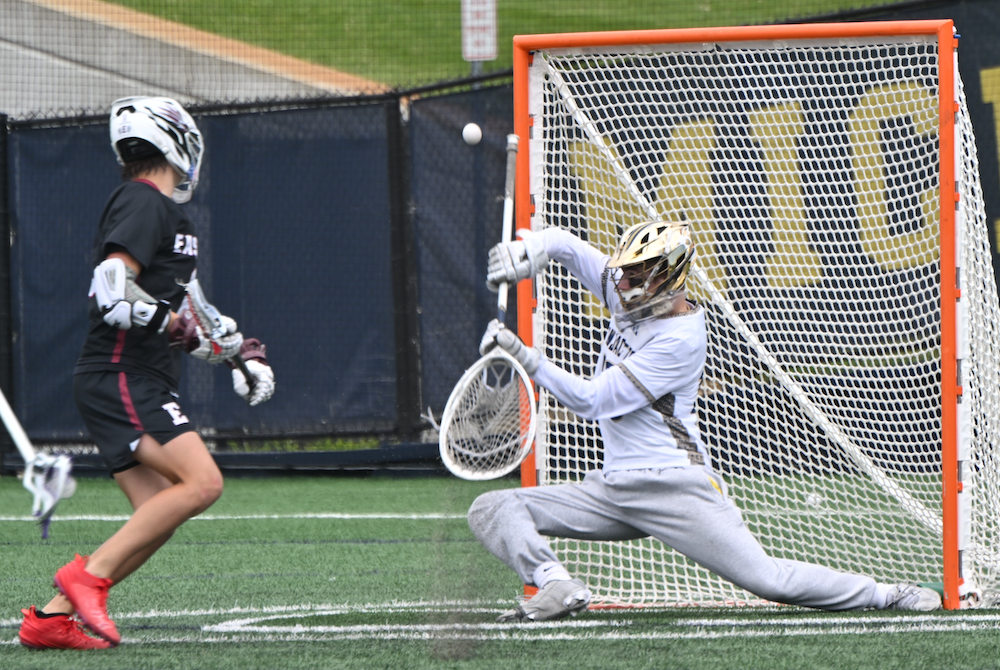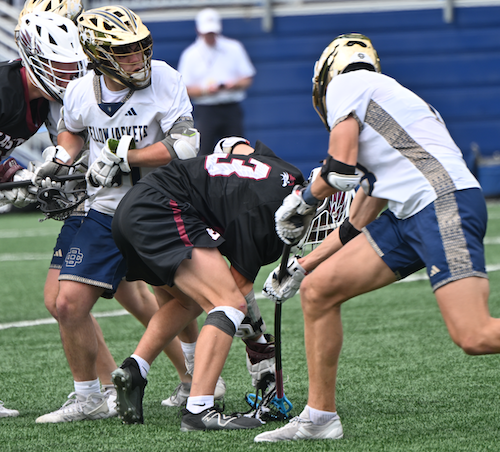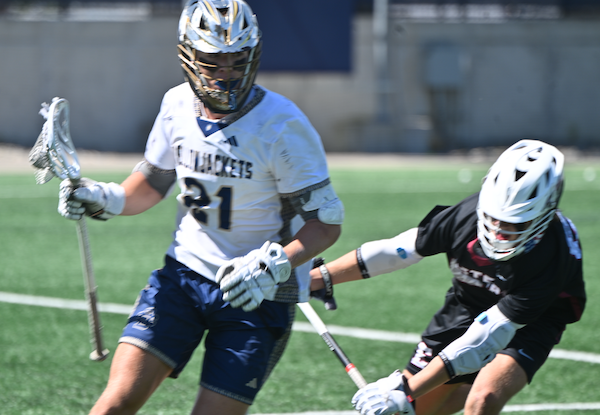
Keep on Coaching
February 1, 2013
By Geoff Kimmerly
Second Half editor
A few weeks ago, I finally got my first chance this season to watch a friend coach his basketball team. After guiding some others at the lower levels, this is his first time running the varsity – something he wasn't sure he wanted to do with a 1-year-old just learning to walk, but a challenge he ended up taking on to the benefit of all those involved.
Simply put, he’s good. I've seen a lot of teams and a lot of coaches over the past 15 years, and although I wouldn't know much of what to do if I were walking the sideline, I felt pretty qualified in telling him I was impressed – even if he didn't buy that I was offering an unbiased opinion. The best news is he’s gone from not sure about this a few months ago to talking about next season.
We know, at least anecdotally, that coaching continues to get more challenging. The time commitment has grown substantially to make running a program a year-round endeavor in a lot of sports at a lot of schools.
That commitment – especially for coaches with children of their own – was a main reason referred to in a New Haven Post-Chronicle story Saturday that noted 23 football coaching openings in Connecticut at one point this offseason. That state has 146 football teams – meaning roughly 15 percent will have new leaders this fall.
And that got me thinking about my friend, about how glad I am he’s given this a shot, and how I've seen so many others either not do so, or not stick around long despite having some pretty nice success.
A study published last winter in Interscholastic Athletic Administration magazine – a product of the National Interscholastic Athletic Administrators Association – noted some predictable results of a study that sought to determine the biggest challenges faced by first-year high school coaches.
The toughest according to the study was balancing the demands of coaching and teaching, experienced by nearly half the respondents – 98 percent of which coached high school teams and 81 percent of which are teachers.
The next six reasons all were noted by at least 30 percent of those in the study – personal fatigue, securing community support, securing and caring for facilities and equipment, parental contact, keeping non-starting players motivated, dealing with schedule interruptions and motivating athletes to achieve consistent, peak performance.
Nothing there is earth-shaking, and most if not all of these challenges are faced by high school coaches regardless of how long they've been in the field. But I got a little more perspective from some of the 32 items that ranked as least challenging to the first-year leaders – keeping in compliance with state and league regulations, dealing with substance abuse issues, teaching sport skills and creating a positive team atmosphere – things that seem most important, and yet appear to be easiest to do. I’m not sure what that tells us – but I think it tells us something.
Click to check out the entire three-page breakdown of the study, plus the researchers’ recommendations to remedy some of what first-year coaches face.
Giving back to Saginaw
I love reading about high-level athletes – like a star-studded group of alums from Saginaw – giving back to where they got their starts.
Pittsburgh Steelers star LaMarr Woodley made a big impact before the start of this school year by donating $60,000 to cover all participation fees for athletes in his former school district. The Saginaw News’ Hugh Bernreuter writes today about how Woodley (Saginaw High), the Philadelphia 76ers’ Jason Richardson (Saginaw Arthur Hill) and former Oakland Raiders standout Stu Schweigert (Saginaw Heritage) have combined to give more than $865,000 back to their home communities.
Bernreuter also mentions the non-monetary contributions of the Golden State Warriors’ Draymond Green (Saginaw High) and former Indianapolis Colts receiver Blair White (Saginaw Nouvel).
Click to read more about it.
Quote(s) of the Week
While rifling through more papers on my desk, I found an article from the Washington Post from Sept. 2011 titled “How high school sports save our schools.” I was drawn to it in part because I spent more than a decade in a newsroom, and it was a piece by a reporter covering education who instead of reporting on school boards and the like, delved into the importance of interscholastic athletics to education as a whole.
He spoke of how participation continues to grow even as resources dwindle, and of data supporting that extracurriculars like sports are more effective than academic classes in teaching leadership, teamwork, time management and “other skills crucial for success in the workplace.” Later, he mentioned a study noting that those who participate in extracurriculars earned more a decade later.
Click here to read the entre piece. These passages struck me most.
“Coaches might be the only faculty members still allowed by our culture and educational practice to get tough with students not making the proper effort. They have the advantage of teaching what are essentially elective non-credit courses. They can insist on standards of behavior that classroom teachers often cannot enforce because the stakes of dismissing or letting students drop their courses are too high. …
“Students do better in activities they choose. If we provide more of them, led by committed adults … that can make a difference. We know the bad news about education. Dropout rates are high. Achievement scores are stagnant. But sports participation is going up, despite pressure to cut it back. Let’s cheer about that and look for a way to draw in more students.”

Country Day Scores in Record-Setting Fashion to Claim 1st Title Since 2014
By
Drew Ellis
Special for MHSAA.com
June 8, 2024
ANN ARBOR – Heading into Saturday’s MHSAA Division 2 Final, Detroit Country Day coach Chris Garland attributed a lack of offense to why his Yellowjackets came up short in the 2022 and 2023 championship games.
That issue was corrected this time around.
Detroit Country Day put up the second-most goals in D2 Finals history, defeating Ada Forest Hills Eastern 18-7 to claim its first championship since 2014 and fourth overall.
“We have so many skilled players. We are a complete team with tremendous depth,” Garland said of the offense. “We just want to keep putting the ball in the hands of our offense. If you stop one of them, we have another guy that can come at you. We showed that (Saturday).”
One player that Forest Hills Eastern didn’t have an answer for was Country Day sophomore Keaton Yearego. He matched a MHSAA Finals record with six goals, three coming during a 5-0 rally in the second period that put the Yellowjackets ahead for good at 8-4.
 “I have a lot of confidence in my team, and my coaches have a lot of confidence in me and allow me to play my game,” Yearego said. “I have some great senior attackmen around me that help me do my thing. Today was just my day.”
“I have a lot of confidence in my team, and my coaches have a lot of confidence in me and allow me to play my game,” Yearego said. “I have some great senior attackmen around me that help me do my thing. Today was just my day.”
The Hawks (16-5) tried to set the tone early, posting the first two goals of the game when junior Jackson Arnold and senior Will Morgan each found the net during the opening minutes.
“I loved the energy. The boys came out to play right from the get-go,” Forest Hills Eastern coach Antonio Boggiano said. “We knew right away that we weren’t happy just getting to this moment. We actually wanted to compete for the championship.”
The Yellowjackets (19-2) didn’t let the early deficit affect them and answered with three straight goals, two coming from senior Oliver Aaron.
“We’ve faced that kind of challenge before. It’s nothing new for us. We’re a resilient team,” Aaron said. “When you have a strong bond with your teammates and can rely on them, you can bounce back from those slow starts.”
The Hawks answered with the last goal of the first period from junior Bradyn Campbell. Senior Preston Hoexum then found the net to open the second to put Forest Hills Eastern up 4-3.
That’s when Country Day got rolling offensively. The Jackets scored 14 of the next 16 goals over 26 minutes of play.
Most of the scores came unassisted, as the Yellowjackets won individual battles to get open looks at the net.
 “We have a lot of offensive threats on our team, so if one way isn’t working, we know we have other options,” Yearego said. “We really just executed well and showcased how many different ways we can score. It was an unbelievable performance.”
“We have a lot of offensive threats on our team, so if one way isn’t working, we know we have other options,” Yearego said. “We really just executed well and showcased how many different ways we can score. It was an unbelievable performance.”
The offensive dominance showed in a 49-22 shot advantage for Country Day. The score could have been even more in favor of DCD, but Hawks goalie Camden Klaes made 15 saves in net.
Morgan and Campbell both finished with two goals to lead Forest Hills Eastern, which made its first Finals appearance since 2021.
“I’m just proud of the boys, just for overall the season we have had,” Boggiano said. “We met in October and said right then and there that we were going for this ring. We came up a little bit short, but I’m just extremely proud of (the team). They overcame a lot of adversity.”
Aaron finished with four goals for Country Day to go with Yearego’s six. Preston Cook, Caden Daley and Rhys Kenney all found the net twice.
PHOTOS (Top) Country Day goalie Kellen Curby makes a save during Saturday’s Division 2 Final. (Middle) Country Day and Forest Hills Eastern players scramble for the ball. (Below) DCD’s Joe Norton (21) works to get into the open.

